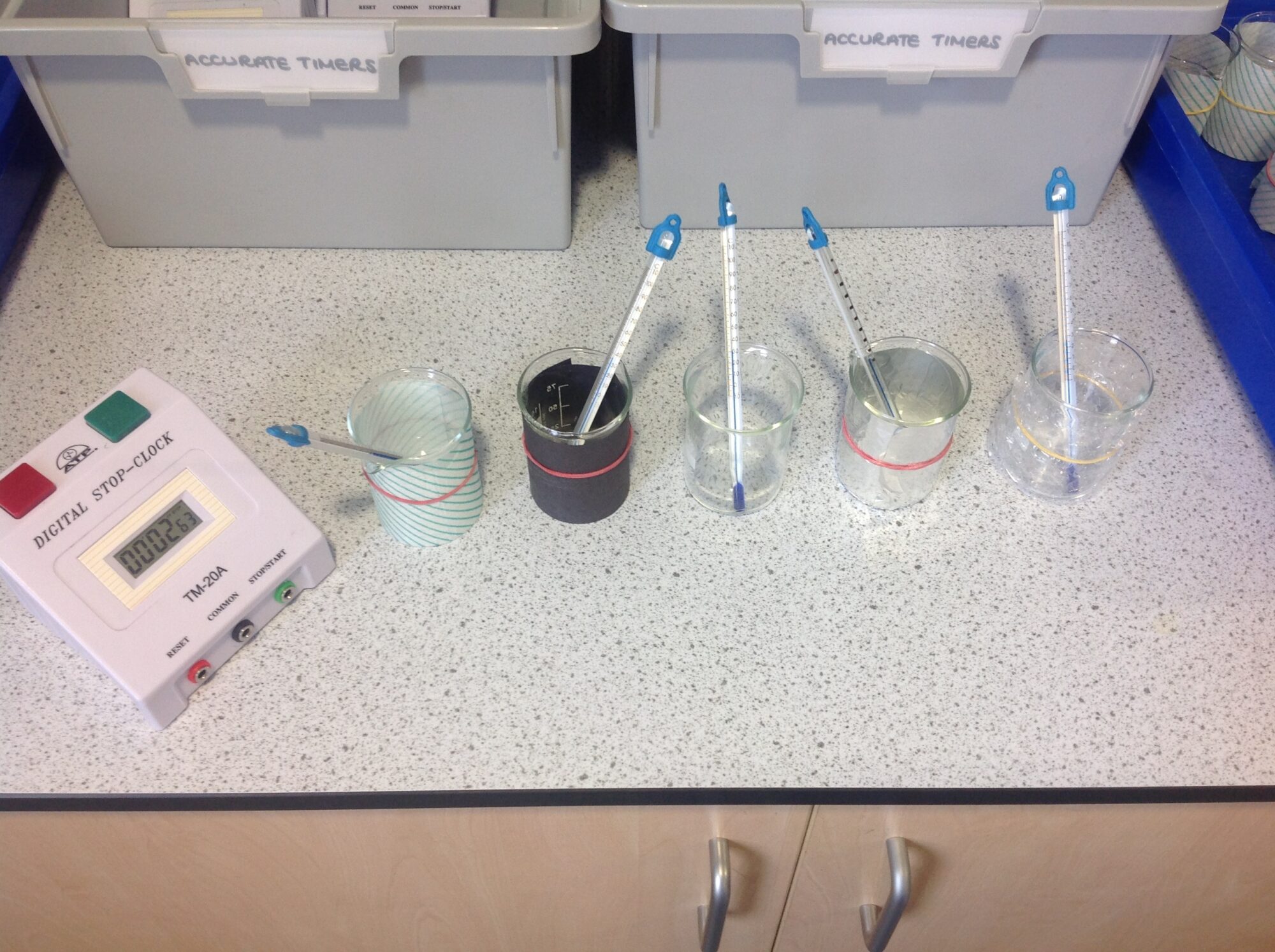Step 1
Label two glasses, A and B respectively.
Step 2
To glass A, add two teaspoons of vinegar and measure its temperature by a thermometer.
Step 3
Leave the thermometer in the cup and continue to measure the temperature until it rests at a set temperature (probably about room temperature).
Step 4
When the temperature is stable, add half a teaspoon of baking soda to the vinegar.
Step 5
Observe the temperature change with the thermometer.
Step 6
To cup B, place a ball of steel wool and the thermometer.
Step 7
Cover the cup and measure the temperature with the thermometer, remember to wait until the thermometer has stabilised, and is no longer changing.
Step 8
Soak the steel wool for one minute in vinegar.
Step 9
Remove the steel wool and squeeze it to remove the excess vinegar.
Step 10
Place the steel wool back into the cup and record the change in temperature with the thermometer.
The steel wool can contain sulfur impurity which may cause the generation of hydrogen sulfide when in contact with vinegar. Though the amount of gas produced is at low concentrations and there is no significant health risk, we would recommend that you carry out this experiment in a well-ventilated environment.
The thermometer used may contain mercury. Please be careful not to leave the thermometer by the edge of the bench so as not to drop it.
Wear protective clothing, such as nitrile gloves and safety glasses, especially when handling steel wool.
Be careful with any glassware, if they are any breakages, tidy up the broken glass in a safe manner.
Have you ever tried to manipulate the distance between the opposite poles of two magnets? Was it more difficult to push the magnets close to each other or was it more difficult to pull the magnets apart? As one may note, trying to separate two magnets stuck together requires energy to pull them apart. This is representing an endothermic reaction, where enough energy is needed to break a chemical bond of the compound. On the other hand, it is relatively easy for the magnets to pull on each other, snapping into place and clicking as the two ends meet, this is the energy released by the process. This demonstrates an exothermic reaction, in which as the chemical bonds form, energy is released (as heat) with the formation of the new product.
Imagine having a child who really enjoys eating sweets, in a room with a table filled with different kinds of treats. The child will quickly move towards the table to eat the sweets. The same applies when a chemical bond is formed between two substances in an exothermic reaction, where energy is given off. Having said that, it will be much more difficult and will require more effort to move the child away from the table of sweets. This is similar to supplying the required energy needed to break a chemical bond of a compound, such as in endothermic reactions.
What is an endothermic reaction?
An endothermic reaction absorbs energy from its surroundings as heat, causing the temperature to drop.
What is an exothermic reaction?
Exothermic reactions release energy to its surroundings as heat causing temperature to increase.
Why is it important for the excess vinegar to be removed from the steel wool?
So as the iron can be exposed to the oxygen in the air, allowing for the oxidation reaction to occure.
Why does the steel wool turn brown after it is soaked in ethanoic acid (vinegar)?
TThe ethanoic acid exposes iron to oxygen in the air and rust forms. Rust is brown in colour.
Why are bubbles observed during the reactions?/strong>
Bubbles indicate the formation of gas. In this case the release of carbon dioxide.
Mixing two chemicals together and causing a chemical reaction is often accompanied by heat (thermal) energy changes. If a reaction raises or lowers the environmental temperature depends if the reaction is endothermic or exothermic. Breaking chemical bonds usually requires energy, drawing in heat from the surroundings, resulting in an endothermic reaction. In contrast, the formation of new chemical bonds gives off energy to the surrounding, usually in the form of heat, resulting in an exothermic reaction.
Ethanoic acid, also known as acetic acid or vinegar, and baking soda are a representation of an endothermic reaction. Such reaction is accompanied by the formation of bubbles and the lowering of the surrounding temperature. This is an indication that the energy required to break down the bonds within the reacting compounds is less than the energy released from the formation of the new ones. https://books.google.co.uk/books?id=2NAiDgAAQBAJ&pg=PA45&dq=vinegar+and+baking+soda+exothermic&hl=en&sa=X&ved=0ahUKEwiO7rLGsd_VAhUCIVAKHUjjDPAQ6AEIKDAA#v=onepage&q=vinegar%20and%20baking%20soda%20exothermic&f=true
For the exothermic reaction, the steel wool soaked in ethanoic acid turns rusty as the acid removes the protective layer on the steel wool, exposing the iron to air. When this happens, the iron reacts with the oxygen in the air to form rust, whilst releasing heat to the surrounding. The release of heat is measured as the temperature increase of the surroundings. https://assist.asta.edu.au/print/3684
Endothermic reactions result in an increase in energy inside the reaction system, as energy is taken from the surroundings. Exothermic reactions are reactions that release energy and are accompanied by an increase in temperature in the surrounding area. Exothermic reactions occur when less energy is required to break the bonds of the reactants than the energy that is released from the formation of the new bonds of the products. Therefore, given that there is a decrease in the energy inside the reaction system, exothermic reactions have a negative change in enthalpy. http://sciencing.com/vinegar-experiment-endothermic-exothermic-reactions-18163.html
Being a base and an acid respectively, sodium bicarbonate and ethanoic acid react upon mixing, as the acid donates a proton to the base. The sodium bicarbonate breaks into two ions, the positively charged sodium ion (Na+) and the negatively charged bicarbonate ion (HCO3-). Ethanoic acid also breaks down into two ions, the positively charged hydrogen ion (H+) and the negatively charged (CH3COO–) ion. The bicarbonate and the acid react to form sodium acetate (CH3COONa), water (H2O) and carbon dioxide (CO2). Carbon dioxide is easily observed due to the release of bubbles. Such reaction required more energy than the energy that is released from the formation of the new substances. http://scienceline.ucsb.edu/getkey.php?key=4147
C2H4O2 + NaHCO3 CO22O+NaC2H3O2
For the exothermic reaction, upon dissolving the protective coating on steel wool with vinegar, when the iron is exposed to oxygen in the air an exothermic reaction occurs, which causes the observable change in temperature. Rusting is an oxidation reaction where electrons from oxygen move onto the iron, to produce rust, composed of the hydrate iron oxide, Fe2O3.nH2O. Excess vinegar on the steel wool interferes with the oxidation reaction as it will also react with the iron from the steel wool to form iron acetate and hydrogen gas instead of rust. This means that the increase in temperature will be less and the experiment will not be as successful.
https://assist.asta.edu.au/print/3684
When a large amount of heat energy is released in a relatively short period of time, in a small volume, a chemical explosion occurs. http://www.chemistryexplained.com/Di-Fa/Explosions.html
Applications
In treating sports injuries, instant cold packs are used, which are based on the principles of exothermic and endothermic reactions. Cold packs have two compartments, one of solid ammonium nitrate, and one of water, when the bag is squeezed, the solid dissolves in the water, causing an endothermic reaction and cooling the bag. Heat packs have the same principles but make use of anhydrous calcium chloride instead, that dissolves in the water causing an exothermic reaction and releasing heat. https://www.sciencebuddies.org/science-fair-projects/project-ideas/Chem_p081/chemistry/how-do-cold-packs-work#background
Exothermic reactions, including the burning of coal, oil or gas, produce heat, that is used to transform water into steam in a boiler. This in turn converts the heat energy into kinetic energy by driving the turbine that drives a generator. Finally, the kinetic energy is converted to electrical energy to produce electricity. http://www.bbc.co.uk/bitesize/standard/physics/energy_matters/generation_of_electricity/revision/1/
Research
New research and developments are being carried out on applications that use exothermic and endothermic reactions. An example of which is research being done on developing tools, to grasp a better understanding of the charging and discharging of a battery and the efficiency at which this occur in different temperatures. http://ma.ecsdl.org/content/MA2016-02/3/341.abstract
Try measuring the change in temperature when a different amount of baking soda is added to the vinegar. It should be observed that up to a certain amount, the greater the amount of baking soda added, the greater the rise in temperature.
Replace ethanoic acid with a range of other liquids such as water, oil and soft drinks and investigate any change in temperature. Ethanoic acid is the only solvent that produces a rise in temperature.



